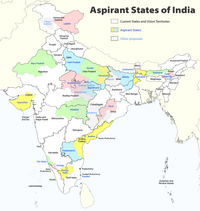

In India, there are autonomously administered territories for Scheduled Tribes, administered by representatives of those tribes. The Sixth Schedule of the Constitution of India allows for the formation of Autonomous District Councils and Autonomous Regional Councils in Assam, Meghalaya, Mizoram, and Tripura, granting them autonomy within their respective territories. Currently, there are 10 Autonomous District Councils across these four states. In these areas, Acts of Parliament and state legislation do not apply.
Additionally, other autonomous councils, created by individual states through state legislation, exist in Northeast India, Ladakh, and West Bengal. Unlike those under the Sixth Schedule, these councils are subject to parliamentary and state laws.
Powers and competencies
Executive and legislative powers
Under the provisions of the Sixth Schedule of the Constitution of India, autonomous district councils can make laws, rules and regulations in the following areas:
- Land management
- Forest management
- Water resources
- Agriculture and cultivation
- Formation of village councils
- Public health
- Sanitation
- Village and town level policing
- Appointment of traditional chiefs and headmen
- Inheritance of property
- Marriage and divorce
- Social customs
- Money lending and trading
- Mining and minerals
Judicial powers
Autonomous district councils have powers to form courts to hear cases where both parties are members of Scheduled Tribes and the maximum sentence is less than 5 years in prison.
Taxation and revenue
Autonomous district councils have powers to levy taxes, fees and tolls on: building and land, animals, vehicles, boats, entry of goods into the area, roads, ferries, bridges, employment and income and general taxes for the maintenance of schools and roads.
Constitutional autonomous councils
There are 10 Autonomous District Councils created by the Sixth Schedule of the Constitution of India:
| State | Autonomous District Council | Headquarters | Formation | Chief Executive Member |
|---|---|---|---|---|
| Assam | Bodoland Territorial Council | Kokrajhar | 2003 | Pramod Boro |
| North Cachar Hills Autonomous Council | Haflong | 1952 | Debolal Gorlosa | |
| Karbi Anglong Autonomous Council | Diphu | 1952 | Tuliram Ronghang | |
| Meghalaya | Garo Hills Autonomous District Council | Tura | 1973 | Benedick R Marak |
| Jaintia Hills Autonomous District Council | Jowai | 1973 | T Shiwat | |
| Khasi Hills Autonomous District Council | Shillong | 1973 | Titosstarwell Chyne | |
| Mizoram | Chakma Autonomous District Council | Kamalanagar | 1972 | Rasik Mohan Chakma |
| Lai Autonomous District Council | Lawngtlai | 1972 | V. Zirsanga | |
| Mara Autonomous District Council | Siaha | 1972 | M Laikaw | |
| Tripura | Tripura Tribal Areas Autonomous District Council | Khumulwng | 1982 | Purna Chandra Jamatia |
Statutory autonomous councils
Some states have created autonomous councils by an Act of their state legislatures. The two autonomous councils in the union territory of Ladakh was created by the state of Jammu and Kashmir (1952 – 2019).
De facto self-governing areas
North Sentinel Island
North Sentinel Island is situated in the island chain of the Andaman and Nicobar Islands which is a union territory of India. It is home to the Sentinelese people, who are among some of the world's last uncontacted peoples. They reject any contact with other people and are among the last people to remain virtually untouched by modern civilization. There has never been any treaty with the people of the island nor any record of a physical occupation.
The Andaman and Nicobar Administration has stated that they have no intention of interfering with the Sentinelese's lifestyle or habitat. Although the island is likely to have suffered seriously from the effects of the December 2004 tsunami, the survival of the Sentinelese was confirmed when, some days after the event, an Indian government helicopter observed several of them, who shot arrows at the hovering aircraft to repel it.
Although this has not been done with any formal treaty, the official policy of minimal interference has ensured that they have de facto autonomy and sovereignty over their island under the framework of the central and local governments.
See also
- Administrative divisions of India
- States and union territories of India
- List of autonomous areas by country
References
- ^ "Sixth Schedule of The Constitution of India" (PDF). Archived (PDF) from the original on 27 October 2019. Retrieved 27 October 2019.
- "Union Cabinet approves amendment in Sixth Schedule to strengthen 10 North East autonomous councils". 24 January 2019. Archived from the original on 28 October 2020. Retrieved 3 November 2019.
- ^ "Autonomous District Councils Manipur in brief By Haokholal Hangshing". e-pao.net. Archived from the original on 20 September 2022. Retrieved 19 May 2022.
- "MCS, MPS officers transferred : 16th jul22 ~ E-Pao! Headlines". e-pao.net. Archived from the original on 7 April 2023. Retrieved 7 April 2023.
- The Sentineli Archived 2 March 2009 at the Wayback Machine.
- "Administration in India's Andaman and Nicobar Islands has finally decided upon a policy of minimal interference". Archived from the original on 14 September 2012. Retrieved 21 August 2008.
External links
| Geography of India | |
|---|---|
| Geology | |
| Culture | |
| Landforms | |
| Regions | |
| Geographical regions | |
| Subdivisions | |
| Ecology | |
| Central India |
|  |
|---|---|---|
| East India | ||
| North India |
| |
| Northeast India |
| |
| South India |
| |
| West India |
| |
| Current states and union territories of India | ||
| 6th Schedule areas (Constitution of India) |
| ||||||||
|---|---|---|---|---|---|---|---|---|---|
| Non-6th Schedule areas (State legislation) |
| ||||||||
